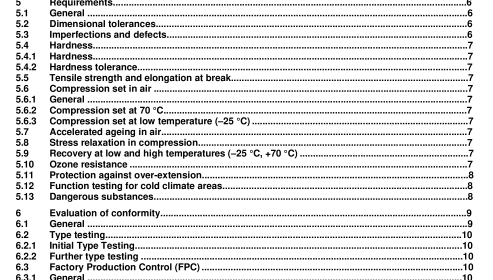BS EN 14188-3:2006 – Joint fillers and sealants — Part 3: Specifications for preformed joint seals

1 Scope
This European Standard specifies requirements for preformed joint seals made of vulcanised rubber for concrete pavements.
General requirements for finished joint seals are also given. This European Standard is applicable to joint seals for joints in new concrete pavements and maintenance work in concrete highways.
2 Normative references
The following referenced documents are indispensable for the application of this European Standard. For dated references, only the edition cited applies. For undated references, the latest edition of the referenced document (including any amendments) applies.
EN 14840, Joint fillers and sealants — Test methods for preformed joint seals
EN ISO 9001 , Quality management systems — Requirements (ISO 9001:2000)
ISO 48, Rubber, vulcanised or thermoplastic — Determination of hardness (hardness between 10 IRHD and 100 IRHD)
ISO 3302-1 , Rubber — Tolerances for products — Part 1: Dimensional tolerances
3 Terms and definitions
For the purposes of this European Standard, the following terms and definitions apply.
3.1
joint
vertical discontinuity between the adjacent faces of slabs in the concrete layer of a pavement, formed for the purpose of providing some movement capability
3.2
joint chamber
cut into the upper part of the joint to offer a seating for the preformed joint seals. The width of the chamber depends on the movement capability of the preformed joint seals. The bottom of the chamber supports the preformed joint seals to withstand vertical forces by traffic
3.3
preformed joint seals
extruded (preformed) and vulcanised elastic rubber profile that, when inserted by special machines into the joint chamber, seals the joint by compression reaction to appropriate surfaces within the joint chamber to fill the joint and to prevent ingress of water
NOTE The behaviour of a preformed joint seals is mainly influenced by the elastomer. In this application mainly the following elastomers are used:
— EPDM rubber: Ethylen-Propylen-Dien-Monomer rubber,
— CR rubber: Chloroprene Rubber.
3.4
rubber hardness degree
reaction forces of compressed preformed joint seals depend on geometry and rubber hardness of preformed joint seals. Hardness is measured in IRHD. IRHD is the international rubber hardness degree in accordance with ISO 48
NOTE The higher the hardness degree, the higher is the reaction force. The softer the hardness degree is, the better is the ability for the lips of the rubber profile to lean tight to surface roughness of the cut joint chamber.
3.5
manufacturer´s limiting value MLV
manufacturer’s stated minimum or maximum value to be met during testing according to the requirements of this European Standard
3.6
manufacturer´s declared value MDV
value declared by the manufacturer accompanied by a declared tolerance
3.7
cold climate area
area in which the temperature can go below –25 °C and the opening of the joint can exceed 35 %
BS EN 14188-3:2006 – Joint fillers and sealants — Part 3: Specifications for preformed joint seals